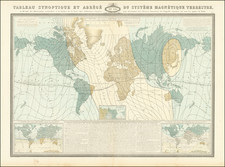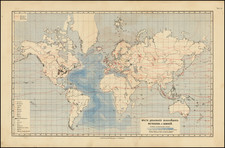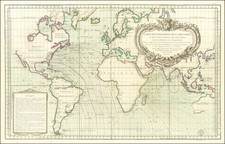Fine Example of One of Earliest Obtainable Maps to Use "America" and Show a Western Ocean
Fine example of the first state of Vadianus' scarce oval projection published by Zurich's first printer, Christopher Frosch. This is one of the earliest obtainable maps to show an ocean to the west of the American continent, which is not yet named. It is also one of the earliest obtainable maps to use the name America, the first being the Waldseemuller map in 1507 (one known example) and the second (and earliest obtainable) being the Peter Apian map of 1520.
The map shows North America as a narrow unrecognizable sliver, while South America is recognizable. The Old World appears much as we know it, except for the "tail" that seems to connect the East Indies to the continent of Asia. This "tail" is a remnant of the Ptolemaic world map that depicted the Indian Ocean as an inland sea surrounded by land. Here, there are no lands to the south, although Scandinavia extends right to the North Pole. The map shows a passage between the Americas and Terra de Cuba in North America rather than an isthmus.
The toponyms used on the map are an eclectic mix of Ptolemaic and modern geographical place names. The use of Cuba for North America shows the confusion that abounded after Columbus' discoveries as to the islands' and the continent's geographic relation. Mountain ranges and river systems are marked inland, while two ships and a lone sea monster patrol the waters of the graticule.
While the map bears some similarity to the Munster-Holbein map of 1532, especially with regard to the Americas, there are a number of changes. Vadianus replaces the Ptolemaic projection for India and Sri Lanka with a much more modern depiction of Southwestern Asia, based upon the recent Portuguese voyages of exploration. The later map is also less pronounced in the tail in Southeast Asia and in the thrust of land in northern Russia, although it is more pronounced in the northward reach of Scandinavia. The treatment of the southern portion of Africa is also much improved, but extends ten degrees too far to the south. Interestingly, the Holbein map includes Japan to the far west, while Vadianus chooses to exclude the island. In addition, the islands of the Caribbean have been removed.
The map is surrounded by twelve windheads, a typical trope for map decoration in the mid-sixteenth century. Vadianus has chosen to retain the Classical twelve windheads, as opposed to the eight-point compass rose adopted by mariners in the Middle Ages. Each wind direction bears their own name and the names used here are again a mixture, with an emphasis on the Roman names given the winds by Seneca in Naturales quaestiones (ca. 65 CE) and by Vitruvius in De architectura (ca. 15 BCE)
The many names of Vadianus
Joachim Vadian (1484-1551) was born Joachim von Watt is St. Gallen, Switzerland. Vadianus is the Latinized version of his surname. His family was in the linen trade, but Joachim went to study the arts in Vienna. It was while he was at university that he began to go by Joachimus Vadianus, a change in line with his fellow humanist scholars. After graduating with a Master of Arts in 1509, Vadianus began teaching poetry. He was a professor at the University of Vienna from 1512, was named Poet Laureate by Maximilian I in 1514, and was made Dean of the University in 1516.
Vadianus' interests included more than poetry; he also excelled in the study of medicine and natural philosophy (the sciences). Geography became his particular area of expertise. In 1517 Vadianus graduated with a doctor of medicine and then moved back to St. Gallen, where he became city physician. As the Reformation swept Switzerland, Vadianus chose to support the Reformers. In 1526 he was elected mayor and, under his leadership, the city became and stayed Protestant. Upon his death, he donated his library to the city; it served as the foundation for the cantonal library of St. Gallen, also known as the Vadiana.
Vadianus published several books throughout his lifetime, including works on poetry, a history of the abbots of St. Gallen, and a theological treatise. His most enduring work, though, is his 1534 world atlas, Epitome trium terrae partium Asiae, Africae et Europae compendiariam locorum descriptionem continens . . ., where this map originally appeared. He also contributed maps to Johannes Stumpf's Chronicle (ca. 1548) and wrote a commentary for Pomponius Mela's De Situ Orbis (1540), which is most well-known for its double-cordiform world map by Oronce Fine.
The first publisher in Zurich
Vadianus' map and atlas were published by Christopher Frosch, or Christoph Froschauer (1490-1564), who was the first printer in Zurich. His bible, known as the Froschauer Bible, is famous for it is the translation of the Bible by Hulydrch (Ulrich) Zwingli, the Protestant Reformer. Frosch was a follower of Zwingli and Vadianus knew the cleric personally. Frosch also published the complete works of Zwingli.
Frosch came to Zurich after learning printing from his uncle in Augsburg. Once in Zurich, he built a printing press while working for Han Ruegger and took over the press, and married Ruegger's widow, when the older man died in 1517. The Affair of the Sausages, a dispute over the premeditated eating of sausages during Lent, happened in Frosch's workshop. The eating of sausages, and Zwingli's public support for the action, vaulted Zwingli to fame (or infamy, in the eyes of many of his contemporary clerics) and launched the Reformation in Switzerland.
During his lifetime Frosch printed roughly 700 titles, totaling a million copies, on four presses. He also operated a paper mill in Limmat, which supplied his workshop. After his death, his nephew, known as Christoph Froschauer the Younger, took over the business. There is still a Froschau quarter and Froschaugasse in Zurich, to commemorate the printer and his legacy.
Rarity
This first state of Vadianus' map rarely appears in good condition, having been folded a number of times and bound into Vadianus's Epitome. The book is quite rare, even more so with the world map present.
The first state of Vadianus' map can be distinguished from the second state, which includes the following imprint in the lower banner, " Apud Io. Ludoicum & Guilelmum Richart 1542." There was also a third state, published in Zurich in 1572 with the imprint, " Apud Hieronymum de Marnef & Guilelmum Cauellat." This first state's imprint reads, " Tiguri anno MD XXXIIII." All three states are rare on the market.
This first state of Vadianus' map rarely appears in good condition, having been folded a number of times and bound into Vadianus's Epitome trium terrae partium Asiae, Africae et Europae compendiariam locorum descriptionem continens . . . The book is quite rare, even more so with the world map present.
The first state of Vadianus' map can be distinguished from the second state, which includes the following imprint in the lower banner: "Apud Io. Ludoicum & Guilelmum Richart 1542.









![[ Second World War-Italian Submarine Warfare ] Azione Del Sommergibili Italiani Negli Oceani 1940-1943 [Action of Italian Submarines in the Oceans 1940-1943]](https://storage.googleapis.com/raremaps/img/small/80832.jpg)
![Nova Totius Terrarum Orbis Geographica Ac Hydrographica Tabula. A Pet. Kaerio [First State -- With Handwritten Account of Sir Francis Drake's Voyage on the verso]](https://storage.googleapis.com/raremaps/img/small/81200.jpg)
![[ World ] Air France -- Sur Les Ailes D'Air France Decouvrez Le Monde A Votre Tour](https://storage.googleapis.com/raremaps/img/small/100053.jpg)


